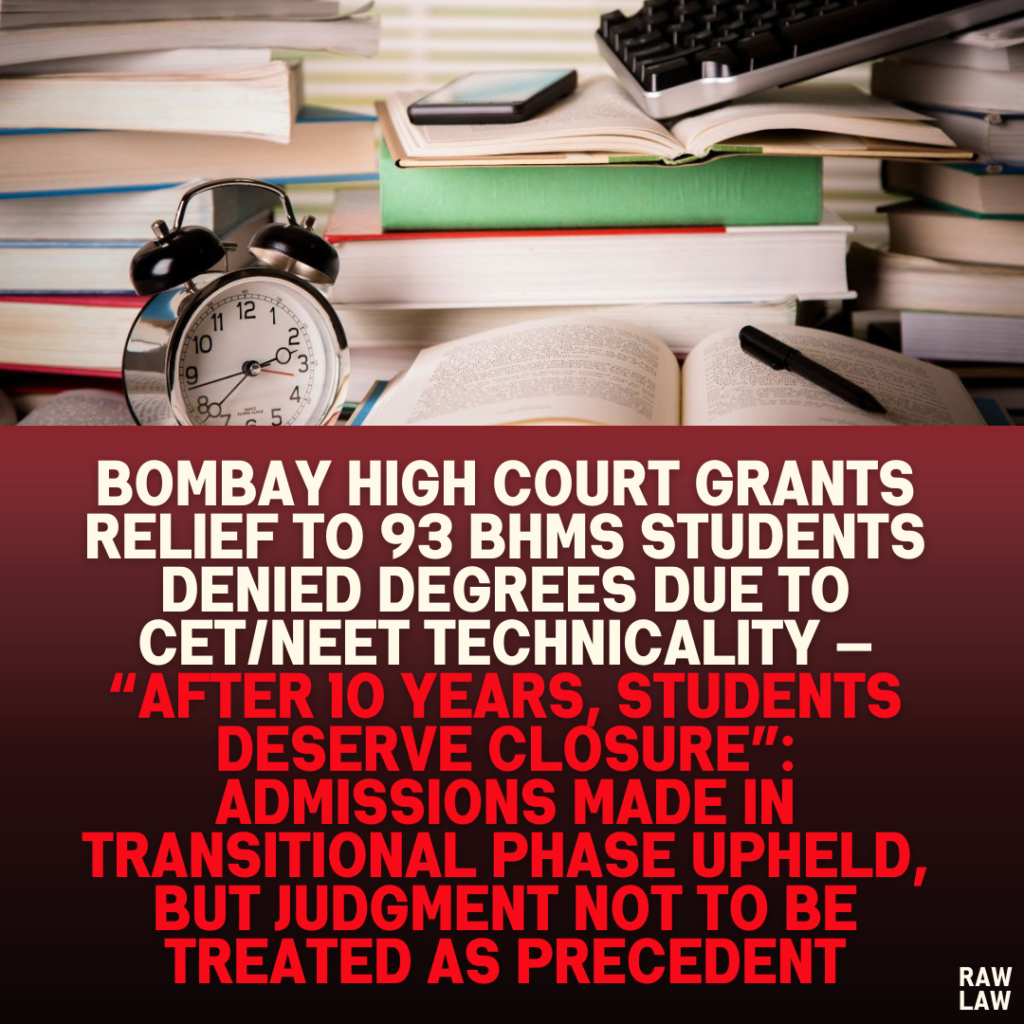Court’s Decision
The Bombay High Court quashed and set aside communications and decisions issued by MUHS and Pravesh Niyantran Samiti that disapproved the admission of 93 students to BHMS courses for Academic Years (AY) 2013–14 and 2014–15. The Court declared these students as eligible for admission and directed MUHS to release their pending marksheets, degrees, and other documents within four weeks. The Court clarified:
“After a period of about 10 years or more, concerned students of the Petitioner Colleges must get a closure and clarity about the cloud hanging over their eligibility.”
This judgment applies only to the 93 students admitted in AY 2013–14 and 2014–15 and is not to be treated as a precedent.
Facts
The petitioner was an association of private unaided homeopathic medical colleges in Maharashtra. The association and its member colleges admitted students to the BHMS course during AY 2013–14 and 2014–15 on the basis of HSC marks or through CETs other than the state CET/NEET-UG.
These admissions were made after the first round of centralized admissions by the State. The association had sought permission from the Samiti to admit students to vacant seats based on HSC (PCB) marks, consistent with earlier years’ practices and the eligibility criteria laid down by the Central Council of Homeopathy (CCH).
However, MUHS and the Samiti refused to approve these admissions and declined to issue eligibility certificates or accept exam forms, leading to the filing of multiple writ petitions.
Issues
- Whether the students admitted on the basis of HSC marks (without CET/NEET-UG) during AY 2013–14 and 2014–15 were eligible for admission.
- Whether the rejection of these admissions by MUHS and the Samiti was justified in law, especially considering prior practices and interim court orders.
Petitioner’s Arguments
- The association argued that the CCH did not mandate CET as an eligibility criterion for BHMS admission, only HSC (PCB) qualification and age.
- Until AY 2012–13, the colleges were allowed to admit students on the basis of HSC marks for vacant seats after the first round of CET/NEET-UG.
- Clause 4.10 of the NEET-UG and MH-CET brochures was only for determining inter-se merit and not eligibility.
- Clause 9.2.6 of the NEET-UG-2013 brochure allowed private colleges to admit students after the first round of CAP.
- The students admitted were protected under interim court orders and completed their courses.
Respondent’s Arguments
- MUHS and the Samiti contended that all admissions must be routed through CET or NEET-UG, as per Clause 4.10 of the brochures.
- They argued that permitting students admitted outside this framework would undermine the merit-based admission system.
- They relied on judgments such as Priya Gupta, TMA Pai, Islamic Academy, P.A. Inamdar, and Modern Dental College to stress the need for uniform entrance tests.
- MUHS opposed recognition of students who took CETs from other states or were admitted without any CET.
- The Ministry of AYUSH (UOI) argued it had no role in the admission process and disclaimed any responsibility.
Analysis of the Law
- The Court noted that Clause 4.5.1.3 of the NEET-UG-2013 brochure exempted BHMS admissions from the requirement of minimum marks applicable to MBBS/BDS/BAMS.
- Clause 9.2.6 of the same brochure allowed only one CAP round for BHMS admissions, after which private colleges could fill vacant seats—a clear policy distinction.
- Clause 10.6 excluded homeopathic colleges from the second round of NEET UG admission, allowing them discretion over remaining seats.
- The CCH regulations under Section 33 of the 1973 Act mandated only HSC (PCB) qualification and age as eligibility, with no requirement of CET or NEET.
Precedent Analysis
The Court distinguished the present matter from:
- Priya Gupta (regarding MBBS/BDS admissions)
- Writ Petition No. 11495 of 2012 (involving nursing courses)
- Rajan Purohit and Maharishi Dayanand University (addressing eligibility versus procedural lapses)
The Court emphasized that those judgments dealt with different courses and did not account for the specific clauses exempting BHMS from certain requirements.
Court’s Reasoning
- The Court found that the respondents had overlooked specific clauses in the admission brochures that clearly allowed private colleges to admit students after the first CAP round.
- The NEET-UG 2013 and MH-CET 2014 brochures carved out explicit exceptions for BHMS admissions.
- The admissions were made in a transitional period when NEET-UG was newly introduced, creating confusion.
- The students had been protected by interim orders, appeared for exams, and successfully completed their degrees.
- The respondents’ objections were technically correct in principle but misapplied to the facts.
Conclusion
The Court allowed all the writ petitions and passed the following directions:
- Quashed the impugned communications and decisions of MUHS and the Samiti.
- Held that all 93 students were eligible for admission.
- Directed MUHS to release all pending marksheets, degrees, and other academic documents within four weeks.
- Clarified that students who discontinued mid-course would not benefit from the ruling.
- Stated that the judgment is limited to AY 2013–14 and 2014–15 and should not be treated as precedent.
Implications
This judgment provides long-awaited relief to 93 students whose degrees were under a cloud for over a decade. While affirming the principle of merit-based admissions, the Court recognized the transitional uncertainty surrounding NEET’s initial implementation and provided a pragmatic resolution based on past practices and student interests. However, the Court was careful to confine the ruling to this particular case to avoid undermining the broader CET/NEET-based regulatory framework for medical education.




Pingback: Supreme Court Rules CBEC (Central Board of Excise and Customs) Circular Granting 1% Customs Duty Drawback to Exporters is Clarificatory and Retrospective — Appellant Entitled to 1% AIR Drawback on Exports Since 2008 - Raw Law